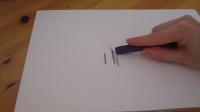VIDEO: Addition procedure for 3 equations
The addition method - basic knowledge
Equations With several unknowns, in the simplest case two equations with the unknowns x and y, three so-called Solve standard procedures. These are equation methods, substitution methods and the addition method, which is not so popular with students, on which the Gaussian algorithm is based.
- To use the addition method, you should first sort the equations according to the unknowns; the numerical value is placed on the right-hand side of the equation. This little preparatory work creates an overview!
- The aim of the procedure is to be skillful by multiplying one (or worse even both) equations with one chosen number to achieve that this unknown drops out when adding the two equations, i.e.: yourself added away.
- The two equations 3x + 2y = 7
- as well as 4x - y = 12
- can be easily edited using this method. First, multiply the second equation by 2 and you get
- 3x + 2y = 7
- and 8x - 2y = 24
- You can already see that in this case the unknown y drops out when adding. After adding the two equations, you get 11x = 31. From this you can calculate the unknown x.
- It is important with the procedure to repeatedly write both equations with the unknowns one below the other, so that You do not lose track of your invoices - this is precisely what makes the addition process not so popular.
A two-digit number is seven times as large - tips for number puzzles
Number puzzles that can be solved with one (or more) equations are a ...
Addition procedure for 3 equations - this is how you proceed
- The addition method, which requires a bit of paperwork, is worthwhile for three equations with three unknowns. No other method leads here so clearly to the goal.
- First you sort the three equations according to unknowns and Counting and write these appropriately among each other. In addition, it can be useful to number the equations consecutively, which is always recommended if there are several unknowns.
- First, you select one of the unknowns that you want to fly out of the procedure. Usually one chooses the unknown that gives the simplest multiplications.
- Now you have to carry out the addition procedure twice, each time for two (!) Equations from your three equations. It is up to you whether you choose "Equation 1 + Equation 2" and then "Equation 2 and Equation 3" or another combination. Under no circumstances may you choose two of the same kind twice.
- After this addition pass, you have two equations with the two remaining unknowns, which you can then solve using a method of your choice.
Addition method - a calculated example with 3 unknowns
In this example, the system of equations (1) 9x = 3 - 2y - 3z, (2) 12 x - y = 6 - 12z and (3) 2x + y - 2z = -4 should be calculated in detail using the addition method.
- Arrange the system and you will get the equations
- (1) 9x + 2y + 3z = 3
- (2) 12x - y + 12z = 6
- (3) 2x + y - 2z = -4
- If you look at the number factors in front of the unknowns in this system of equations, you will probably choose y as the unknown to be thrown out, because this is particularly easy there. Multiply equation (2) by 2 and add this to equation (1):
- (1) 9x + 2y + 3z = 3
- (2) 24x - 2y + 24 z = 12, so you get:
- 888 33x + 27 z = 15
- Now apply the addition procedure a second time. The unknown y flies out if you add equation (2) and (3) directly:
- (2) 12x - y + 12z = 6
- (3) 2x + y - 2z = -4, and you get:
- 121212 14x + 10z = 2
- The two equations from 8. and 12. can now be solved by a method of your choice. This can in turn be the addition method, but does not have to be.


